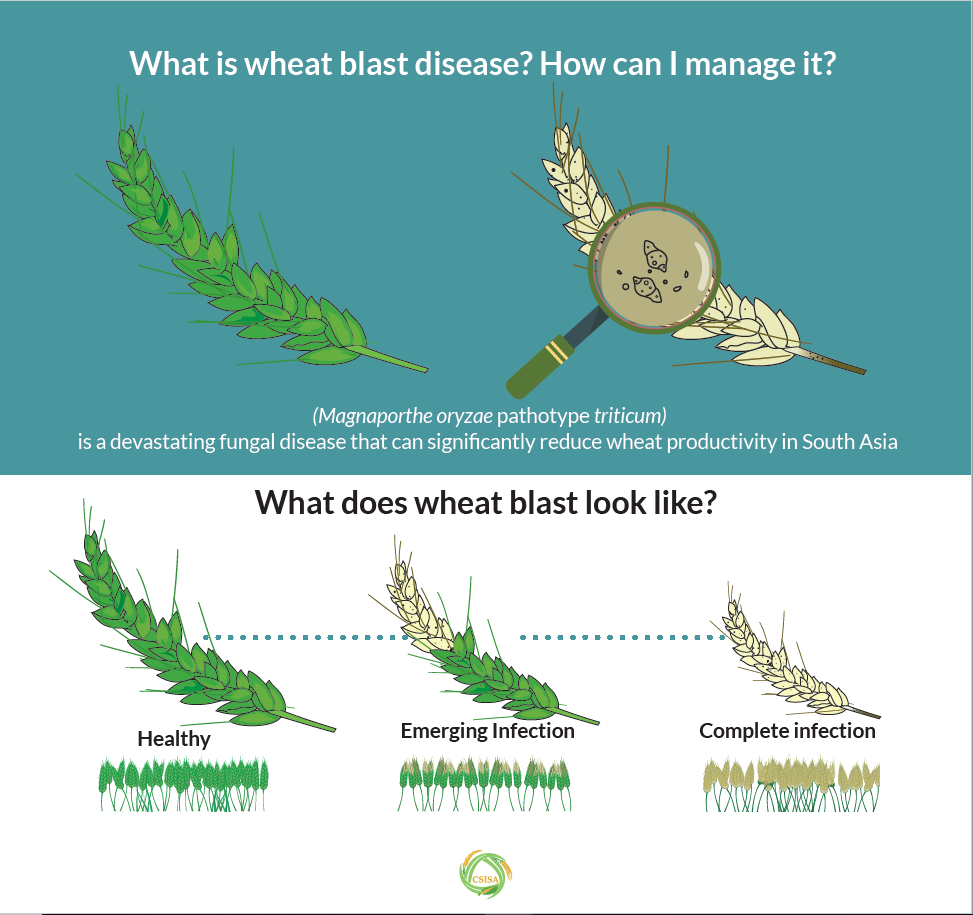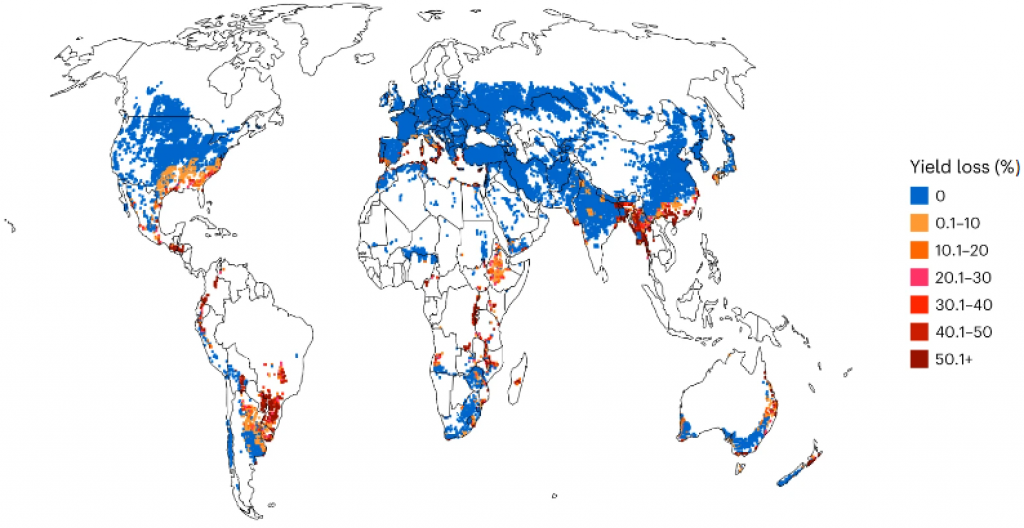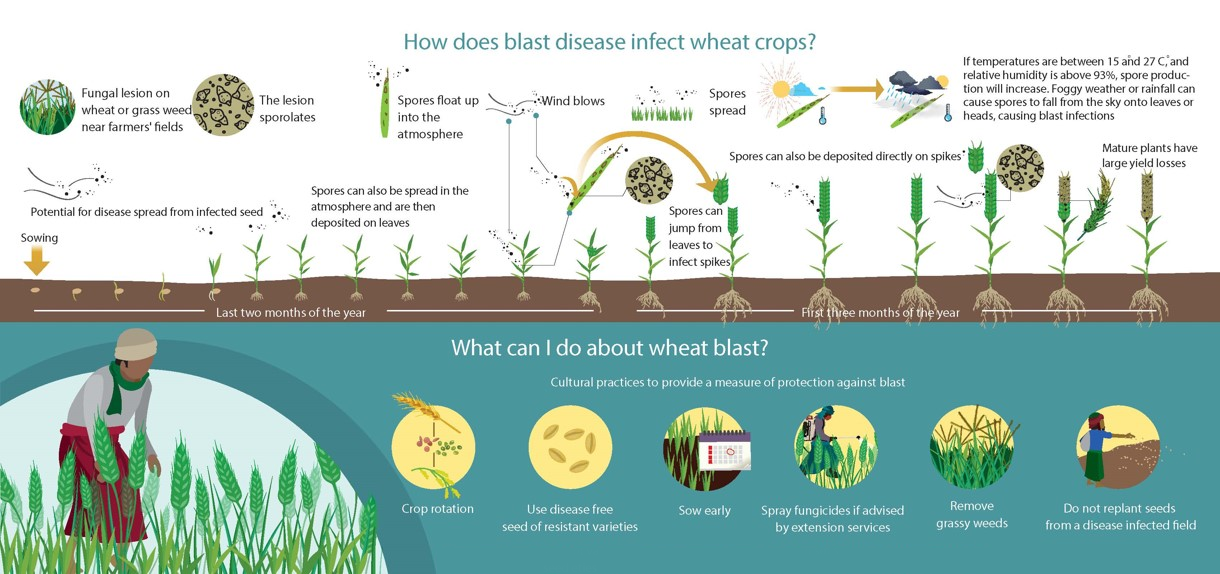Agriculture
Climate Change and Wheat Blast
- 14 Feb 2024
- 10 min read
For Prelims: Wheat Blast, El Niño, Wheat Blast (WB), Climate Change, Food Security.
For Mains: Linked Between Climate Change and Wheat Blast, Major Impacts of Climate Change on Indian Agriculture.
Why in News?
Recently, a new study has been published titled-Production vulnerability to wheat blast disease under climate change, which has warned of links between warming Climate and the fungal plant disease Wheat Blast (WB).
- The study traces the history of WB outbreaks, emphasizing its expansion beyond its original location in South America to Bangladesh in 2016 and Zambia in 2018. The disease is linked to weather conditions influenced by phenomena like El Niño.
What is a Wheat Blast Disease (WB)?
- About:
- Wheat blast disease is a highly destructive fungal infection that primarily affects wheat crops.
- It poses a significant threat to food security and safety, particularly in tropical regions of South America and South Asia.
- The disease is caused by the fungus Magnaporthe oryzae pathotype triticum (MoT).
- Symptoms:
- Leaf Lesions: Small, oval to spindle-shaped lesions appear on the leaves. These lesions may initially be yellow or tan and eventually turn brown or necrotic. They often have a yellow halo surrounding them.
- Stem Lesions: Similar lesions can also develop on the stems of the wheat plants. These lesions can girdle the stem, leading to wilting and lodging of the plant.
- Spikelet Symptoms: Infected spikelets may become blackened and elongated, giving them a spindle-like appearance. This symptom is particularly prominent during the reproductive stage of the plant.
- Impact on Wheat Crops:
- The fungus directly targets the wheat ear, causing it to shrivel and deform within a remarkably short period, often less than a week from the first symptoms.
- This rapid onset leaves farmers with little time to respond, leading to substantial yield losses.
- Wheat blast spreads through various means, including infected seeds, crop residues, and airborne spores capable of traveling long distances.
- The pathogen can infect all aerial parts of the wheat plant, but the most significant damage occurs when it affects the wheat ear.
What are the Key Highlights of the Study?
- Climate Change Impact on Wheat Blast:
- Wheat Blast currently poses a threat to 6.4 million hectares and by 2050, Climate Change is likely to make the situation worse and threaten 13.5 million hectares of cropland.
- Wheat blast is also linked with weather conditions like El Nino.
- A study published in 2018 by the Annual Review of Phytopathology too revealed that all the severe epidemics of wheat blast occurring across South America and Asia during the wet and warm years of 1987, 1997, 2002, 2009, 2012 and 2015 coincided with weather conditions dominated by the El Nino phenomenon.
- Wheat blast alone has the potential to reduce worldwide wheat production by 13%, highlighting the severity of its impact on Global Food Security.
- Vulnerability by Region:
- South America and Africa are identified as the most vulnerable regions to wheat blast in the future climate.
- By 2050, up to 75% of wheat acreage in these regions could be at risk.
- Future Spread and Impact:
- There is potential expansion of wheat blast into new territories, including countries like Uruguay, Ethiopia, Kenya, and Congo.
- It also highlights projections for increased vulnerability in regions like Oceania and North America.
- Previously unaffected countries like Japan, Italy, Spain, and New Zealand are identified as potential targets for wheat blast, highlighting the global nature of the threat.
- Impact on European Region:
- The cold climate in Europe and other countries where snow falls reduces the probability of infection. But climate change will potentially alter the distribution of different insect pests and diseases over time.
- It is possible for European places near the Mediterranean to experience a favourable climate for fungal infection.
- This includes Italy and parts of southern France and Spain.
- Impact on India:
- In India, some parts of the country may become less vulnerable to wheat blast if dry seasonal conditions with more frequent severe high temperatures (over 35 degrees Celsius) occur in the later half of the wheat-growing season in future climates.
- Although the risk of wheat blast infection is decreased by such high temperatures, they also create terminal heat stress, which lowers India's potential output.
What are the Adaptation Strategies Suggested in the Study?
- Shift to Less Susceptible Crops:
- Given the threat to important wheat-growing areas around the world from wheat blast, farmers may need to shift to less susceptible crops to mitigate production and financial losses.
- Multiple Strategies:
- It is suggested to adopt multiple strategies to manage the disease, for instance, maize cultivation is gradually replacing wheat in midwest Brazil.
- Breeding blast-resistant wheat is also a very important strategy that could mitigate future losses in new vulnerable areas and has already been initiated.
- Appropriate Sowing Date:
- Wheat blast-promoting conditions can also be avoided by choosing the appropriate sowing date. The adjustment in planting dates is another effective mitigation strategy against the disease.
- Avoid Early Planting:
- Rain, followed by hot, humid weather during the flowering stage, can promote disease development. It is recommended to avoid early planting in central Brazil and late planting in Bangladesh, as these periods coincide with high temperatures and relative humidity due to increased precipitation levels.
What are the Measures to Combat Wheat Blast?
- The wheat blast-resistant varieties produced by CIMMYT (International Maize and Wheat Improvement Centre) in collaboration with National Agricultural Research Systems partners have proven useful in reducing the impact of wheat blast.
- Developing and promoting wheat varieties resistant to wheat blast is a critical aspect of mitigating the impact of this devastating disease. Examples of wheat varieties that exhibit resistance to wheat blast, including Rmg8 and 2NS
- Rmg8 is a wheat variety developed by researchers at the CIMMYT, which possesses genetic resistance to wheat blast conferred by a specific gene known as Rmg8.
- The 2NS involves transferring a segment of chromosome 2N from a wild relative of wheat, Thinopyrum ponticum, to cultivated wheat varieties. This translocation has been found to enhance resistance to various fungal diseases.
UPSC Civil Services Examination, Previous Year Question (PYQ)
Prelims
Q.1 How is permaculture farming different from conventional chemical farming? (2021)
- Permaculture farming discourages monocultural practices but in conventional chemical farming, monoculture practices are predominant.
- Conventional chemical farming can cause an increase in soil salinity but the occurrence of such phenomenon is not observed in permaculture farming.
- Conventional chemical farming is easily possible in semi-arid regions but permaculture farming is not so easily possible in such regions.
- Practice of mulching is very important in permaculture farming but not necessarily so in conventional chemical farming.
Select the correct answer using the code given below.
(a) 1 and 3
(b) 1, 2 and 4
(c) 4 only
(d) 2 and 3
Ans: (b)
Q.2 Which of the following is the chief characteristic of ‘mixed farming’? (2012)
(a) Cultivation of both cash crops and food crops
(b) Cultivation of two or more crops in the same field
(c) Rearing of animals and cultivation of crops together
(d) None of the above
Ans: (c)
Q.3 With reference to micro-irrigation, which of the following statements is/are correct? (2011)
- Fertilizer/nutrient loss can be reduced.
- It is the only means of irrigation in dry land farming.
- In some areas of farming, receding of ground water table can be checked.
Select the correct answer using the codes given below:
(a) 1 only
(b) 2 and 3 only
(c) 1 and 3 only
(d) 1, 2 and 3
Ans: (c)
Mains
Q.1 What are the present challenges before crop diversification? How do emerging technologies provide an opportunity for crop diversification? (2021)
Q.2 How has India benefited from the contributions of Sir M. Visvesvaraya and Dr. M. S. Swaminathan in the fields of water engineering and agricultural science respectively? (2019)









